Experimental Study on the Initiation and Propagation of Multi-Cluster Hydraulic Fractures within One Stage in Horizontal Wells
Abstract
:1. Introduction
2. Experimental Apparatus and Scheme
2.1. Experimental Apparatus
2.1.1. Large-Scale True Triaxial Testing Machine
2.1.2. Hydraulic Fracturing Pumping System
2.1.3. Acoustic Emission Test System
2.1.4. Strain Monitoring System
2.1.5. Multi-Channel Shunting System
2.2. Sample Preparation
2.3. Multi-Channel Fracturing Wellbore
2.4. Experimental Scheme
2.5. Test Procedure
- (1).
- The sample was placed in the true triaxial loading chamber and acoustic emission probes were sticked at the preset positions of the four surfaces of the sample to effectively monitor the information of fracture initiation and propagation.
- (2).
- The minimum horizontal stress, maximum horizontal stress, and vertical stress were loaded along the X (wellbore direction), Y, and Z directions, respectively. During the loading process, the 3D stress should be loaded simultaneously. Therefore, the set minimum horizontal stress value is loaded first. Then, the maximum horizontal stress and maximum vertical stress are increased to the set maximum horizontal stress value. Finally, the vertical stress was gradually loaded to the set value. This loading method prevents unbalanced loading from causing mechanical shear damage to the specimen. After the tri-axial stress reached the predetermined value, it was held for more than 30 min to achieve a relatively steady stress state in the sample before hydraulic fracturing [34].
- (3).
- The fracturing fluid was injected into the wellbore via the hydraulic fracturing pumping system at a given pumping rate. Simultaneously, the acoustic emission test system, strain monitoring system, and multi-channel shunting system collected data. After the fracturing fluid had been injected synchronously into multiple clusters for a certain amount of time, stop valves were used to plug the channels that were fractured first and fully injected so that the remaining perforation clusters could fully fed. Eventually, all channels were fed completely, i.e., all hydraulic fractures at each perforation cluster could extended completely. Fracturing fluids mixed with tracers of different colors were pre-added to the tracer tubes of multi-channel shunting system to identify the spread range of each cluster fracture.
- (4).
- After test, the sample was split to describe the multi-cluster hydraulic fracture propagation morphology. The morphology of the multi-cluster fracture was reconstructed using a 3D scanner.
3. Results and Analysis
3.1. Analysis of Initiation Pattern
3.1.1. Analysis of Simultaneous Initiation
- (1).
- V-1 open, V-2 open, and V-3 open: With the three channels open, the pressure grew slowly before 290 s, and, then, rapidly increased to a breakdown pressure of approximately 28.4 MPa. After a dramatically decrease, it stabilized at 18.5 MPa. The difference of the cumulative injection volume of the three channels were not obvious before 360 s. Then, the cumulative injection volume of C-1 increased rapidly, and C-2 and C-3 stopped to inject, indicating that CF-1 initiated.
- (2).
- V-1 close, V-2 open, and V-3 open: When the C-1 inlet valve was closed at 531 s, the pressure increased to 33.5 MPa. After a slight drop, the pressure wandered in 29.4 MPa. The C-2 and C-3 entered liquid concurrently, and the inflow rate of C-2 was greater than C-3, which means that CF-2 and CF-3 initiated simultaneously, and CF-3 was the dominant hydraulic fracture.
- (3).
- V-1 close, V-2 open, and V-3 close: The C-3 inlet valve was closed at 694 s, the pressure increased to 33.5 MPa and then dropped, stabilized at 29.3 MPa. At this stage, only C-2 entered the liquid, and the pressure raised but did not exceed the previous breakdown pressure, indicating that the expansion of CF-2 in the previous stage was incomplete.
- (4).
- V-1 close, V-2 open, and V-3 open: When the C-3 reopened at 791 s, the pressure increased slightly, and stabilized at 27.3 MPa. At this stage, C-2 and C-3 were fed simultaneously.
- (5).
- V-1 close, V-2 close, and V-3 open: The C-2 was closed at 832 s, and the pressure was stable at 28.7 MPa which was equal to the extension pressure in the stage 2.
- (6).
- V-1 open, V-2 open, and V-3 open: When the C-1 and C-2 reopened at 867 s, the pressure dropped and stabilized at about 20 MPa. At 925 s, the liquid injection was stopped, and the pressure dropped slowly. At this stage, only the C-1 entered the liquid, indicating that the expansion of CF-1 was more complete.
3.1.2. Analysis of Successive Initiation
- (1).
- V-1 open, V-2 open, and V-3 open: When three channels were open, the pressure increased to a lower breakdown pressure of approximately 25.5 MPa at 265 s. After a sharply decline, the pressure stabilized at 12.2 MPa. Before 265 s, three channels simultaneously injected fracturing fluid with a slow rate. Then, the fracturing fluid only injected into C-1, indicating the formation of CF-1.
- (2).
- V-1 close, V-2 open, and V-3 open: The C-1 inlet valve was closed at 412 s, the pressure increased to a middle breakdown pressure of 29.8 MPa at 431 s. Then the pressure sticked to 15.5 MPa, due to a drastic reduction. After 431 s, the cumulative injection volume of C-2 increased significantly, which means that the formation of CF-2. Compared with CF-1, the breakdown pressure increased by 16.86%.
- (3).
- V-1 close, V-2 close, and V-3 open: When the C-2 inlet valve was closed at 573 s, the pressure increased to a higher breakdown pressure of 31.0 MPa at 586 s. The pressure continued to drop with the increase of time. Meanwhile, the fracturing fluid was concentrated into C-3, which shows that CF-3 generated. Compared with CF-2, the breakdown pressure increased by 4.03%.
- (4).
- V-1 open, V-2 open, and V-3 open: When the C-1 and C-2 reopened at 747s, the pressure dropped rapidly. The pump was stopped at 837 s, and the pressure continued to decrease. At this stage, the fracturing fluid was only entered into C-1. This situation reveals that the extension of CF-1 was more advantageous than CF-2 and CF-3.
3.2. Initiation and Propagation of Multiple Hydraulic Fractures
3.2.1. Stress Differences
3.2.2. Pump Rates
3.2.3. Bedding Structures
3.2.4. Cluster Spacing
3.2.5. Multiple Fractures Interaction
3.3. Strain Response Characteristics
- (1).
- The strain curve raised slightly with the pressure increased. The reason is that the fracturing fluid was injected into the wellbore and gathered at the perforation cluster, causing the deformation of the rock mass and the strain gauge was in tension.
- (2).
- The hydraulic fracture initiated at the perforation cluster and propagated toward the bedding plane. The smaller the distance from the fracture to the bedding plane, the bigger the induced tensile stress on the bedding and the increased value of strain. When the fracture reached the bedding plane, a strain peak formed. If the peak point of the pressure curve is considered as the starting point of hydraulic fracture propagation, the culmination point of the strain curve is considered as the end point. It can be observed the time for CF-1 to extend from the perforation cluster position to the bedding plane was approximately 4 s.
- (3).
- The fracturing fluid collected and spread along both sides of the bedding surface. The strain gauges in the tensile state rebounded slightly and the strain value decreased due to the relative shear slip of the rock mass on both sides of the bedding plane. With the cumulative pressure, another pressure peak was appeared indicating the fracture penetrated the bedding to continue to expand.
- (4).
- After penetrating the bedding, the fracture propagated toward to the boundary of the sample. The strain value maintained a decreasing trend and finally formed a minimum value owing to the strain gauge was subjected to lateral compression by the opening hydraulic fracture. The time for CF-1 to propagate from the perforation cluster to the boundary of the specimen was about 19 s.
- (5).
- After the fracture propagated to the boundary of the sample, a stable fracture channel gradually formed. As a result, the pressure and the width of the fracture gradually decreased and stabilized. The strain value increased first and then stabilized due to the lateral compression of the strain gauge gradually weakened.
4. Conclusions
- (1).
- Two initiation patterns among multiple hydraulic fractures were observed. For simultaneous initiation, the breakdown pressure of the subsequent fracture was lower than or equal to the value of the previous fracture, and the fracturing fluid was injected into multiple channels simultaneously but not evenly distributed. For successive initiation, the subsequent breakdown pressures were gradually increasing, and the fracturing fluid only entered a single channel due to a dominant fracture.
- (2).
- With the simultaneous initiation, the interaction between the fractures was usually attraction. For successive initiation, the subsequent fracture tended to intersect with or deviated from the previous fracture. The interaction was aggravated by the decrease of horizontal stress difference, bedding number and cluster spacing, and weakened by the increase of pumping rates.
- (3).
- As the horizontal stress difference increased, the total area of multiple fractures also increased. By increasing the pump rates, the total area of multiple fractures propagation increased 60%. With the decrease of cluster spacing, hydraulic fracture initiated and propagated at only one perforation clusters, suggesting that the reasonable pump rates and cluster spacing should be adopted on-site fracturing.
- (4).
- The strain response characteristics corresponded with the initiation and propagation of fracture, which was conducive to understanding the fracturing process. In Test 3, the time for hydraulic fracture to propagate from the perforation cluster position to the bedding plane was approximately 4 s. Similarly, the time for fracture to propagate from the perforation cluster position the boundary of the specimen was about 19 s in Test 3.
- (5).
- In this experiment, the simultaneous initiation of multiple fractures could not be observed every time due to the size of the sample. Although the artificial sample is similar to shale in brittleness, it is not as bedding rich as shale, so that the effect of the multiple bedding cannot be explored. The physical simulation test which is more suitable for the field will be carried out in the future. Simulating different cluster numbers and spacings in the real rock, the influencing factors of the unbalanced expansion of multiple fractures will be explored.
Author Contributions
Funding
Institutional Review Board Statement
Informed Consent Statement
Conflicts of Interest
References
- King, G.E. Thirty years of gas-shale fracturing: What have we learned? J. Pet. Technol. 2010, 62, 88–90. [Google Scholar] [CrossRef]
- King, G.E. 60 years of multi-fractured vertical, deviated and horizontal wells: What have we learned? In Proceedings of the SPE Annual Technical Conference and Exhibition, Amsterdam, The Netherlands, 27–29 October 2014; Volume 7, pp. 4894–4925. [Google Scholar]
- Lim, P.; Goddard, P.; Sink, J.; Abou-Sayed, I. Hydraulic fracturing: A marceiius case study of an engineered staging completion based on rock properties. SPE Can. Unconv. Resour. Conf. 2014, 1, 634–644. [Google Scholar] [CrossRef]
- Cheng, Y. Mechanical interaction of multiple fractures-exploring impacts of the selection of the spacing/number of perforation clusters on horizontal shale-gas wells. SPE J. 2012, 17, 992–1001. [Google Scholar] [CrossRef]
- Yew, C.H.; Weng, X. Stress shadow. Mech. Hydraul. Fract. 2015, 177–196. [Google Scholar] [CrossRef]
- Miller, C.; Waters, G.; Rylander, E. Evaluation of production log data from horizontal wells drilled in organic shales. In Proceedings of the North American Unconventional Gas Conference and Exhibition, The Woodlands, TX, USA, 14–16 June 2011; pp. 623–645. [Google Scholar] [CrossRef]
- Cipolla, C.; Lewis, R.; Maxwell, S.; Mack, M. Appraising unconventional resource plays: Separating reservoir quality from completion effectiveness. In Proceedings of the SPE Asia Pacific Oil & Gas Conference and Exhibition, Perth, Australia, 22–24 October 2012; pp. 1–27. [Google Scholar] [CrossRef]
- Gustavo, A.U.C.; Huckabee, P.T.; Molenaar, M.M.; Wyker, B.; Somanchi, K. Perforation cluster efficiency of cemented plug and perf limited entry completions; insights from fiber optics diagnostics. In Proceedings of the SPE Hydraulic Fracturing Technology Conference, The Woodlands, TC, USA, 9–11 February 2016. [Google Scholar]
- Somanchi, K.; Huckabee, P.; Ugueto, G. Insights and observations into limited entry perforation dynamics from fiber-optic diagnostics. In Proceedings of the Unconventional Resources Technology Conference, San Antonio, TX, USA, 1–3 August 2016. [Google Scholar] [CrossRef]
- Sookprasong, P.A.; Hurt, R.S.; Gill, C.C.; Lafollette, R.F. Fiber optic DAS and DTS in Multicluster, multistage horizontal well fracturing: Interpreting hydraulic fracture initiation and propagation through diagnostics. In Proceedings of the SPE Annual Technical Conference and Exhibition, Amsterdam, The Netherlands, 27–29 October 2014; Volume 3, pp. 1991–2005. [Google Scholar] [CrossRef]
- Lecampion, B.; Desroches, J.; Weng, X.; Burghardt, J.; Brown, J.E.E. Can we engineer better multistage horizontal completions? Evidence of the importance of near-wellbore fracture geometry from theory, lab and field experiments 2015. In Proceedings of the SPE Hydraulic Fracturing Technology Conference, The Woodlands, TX, USA, 3–5 February 2015. [Google Scholar]
- Elbel, J.L.; Piggott, A.R.; Mack, M.G. Numerical modeling of multilayer fracture treatments. In Proceedings of the Permian Basin Oil and Gas Recovery Conference, Midland, TX, USA, 18–20 March 1992; pp. 401–408. [Google Scholar] [CrossRef]
- Yamamoto, K.; Shimamoto, T.; Sukemura, S. Multiple fracture propagation model for a three-dimensional hydraulic fracturing simulator. Int. J. Geomech. 2004, 4, 46–57. [Google Scholar] [CrossRef]
- Olson, J.E. Multi-fracture propagation modeling: Applications to hydraulic fracturing in shales and tight gas sands. In Proceedings of the The 42nd U.S. Rock Mechanics Symposium (USRMS), San Francisco, CA, USA, 29 June–2 July 2008. [Google Scholar]
- Wu, K. Simultaneous multi-frac treatments: Fully coupled fluid flow and fracture mechanics for horizontal wells. In Proceedings of the SPE Annual Technical Conference and Exhibition, New Orleans, LA, USA, 30 September–2 October 2013; Volume 7, pp. 5444–5457. [Google Scholar] [CrossRef]
- Olson, J.E.; Wu, K. Sequential versus simultaneous multi-zone fracturing in horizontal wells: Insights from a non-planar, multi-frac numerical model. In Proceedings of the SPE Hydraulic Fracturing Technology Conference, The Woodlands, TX, USA, 6–8 February 2012; pp. 737–751. [Google Scholar] [CrossRef]
- Olson, J.E. Predicting fracture swarms—The influence of subcritical crack growth and the crack-tip process on joint spacing in rock. Geol. Soc. Spec. Publ. 2004, 231, 73–87. [Google Scholar] [CrossRef]
- Sun, Z.; Liu, C.; Huang, Z.; Zhang, R. Mechanical interaction of multiple 3D fractures propagation for network fracturing. In Proceedings of the SPE Asia Pacific Unconventional Resources Conference and Exhibition, Brisbane, Australia, 9–11 November 2015. [Google Scholar] [CrossRef]
- Ren, X.; Zhou, L.; Li, H.; Lu, Y. A three-dimensional numerical investigation of the propagation path of a two-cluster fracture system in horizontal wells. J. Pet. Sci. Eng. 2019, 173, 1222–1235. [Google Scholar] [CrossRef]
- Liu, X.; Qu, Z.; Guo, T.; Sun, Y.; Wang, Z.; Bakhshi, E. Numerical simulation of non-planar fracture propagation in multi-cluster fracturing with natural fractures based on lattice methods. Eng. Fract. Mech. 2019, 220, 106625. [Google Scholar] [CrossRef]
- Liu, X.; Rasouli, V.; Guo, T.; Qu, Z.; Sun, Y.; Damjanac, B. Numerical simulation of stress shadow in multiple cluster hydraulic fracturing in horizontal wells based on lattice modelling. Eng. Fract. Mech. 2020, 238, 107278. [Google Scholar] [CrossRef]
- Sun, T.; Zeng, Q.; Xing, H. A model for multiple hydraulic fracture propagation with thermo-hydro-mechanical coupling effects. Energies 2021, 14, 894. [Google Scholar] [CrossRef]
- El Rabaa, W. Experimental study of hydraulic fracture geometry initiated from horizontal wells. In Proceedings of the SPE Annual Technical Conference and Exhibition, San Antonio, TX, USA, 8–11 October 1998; pp. 166–173. [Google Scholar] [CrossRef]
- Crosby, D.G.; Rahman, M.M.; Rahman, M.K.; Rahman, S.S. Single and multiple transverse fracture initiation from horizontal wells. J. Pet. Sci. Eng. 2002, 35, 191–204. [Google Scholar] [CrossRef]
- Zhou, J.; Zeng, Y.; Jiang, T.; Zhang, B. Laboratory scale research on the impact of stress shadow and natural fractures on fracture geometry during horizontal multi-staged fracturing in shale. Int. J. Rock Mech. Min. Sci. 2018, 107, 282–287. [Google Scholar] [CrossRef]
- Zheng, H.; Pu, C.; Wang, Y.; Sun, C. Experimental and numerical investigation on influence of pore-pressure distribution on multi-fractures propagation in tight sandstone. Eng. Fract. Mech. 2020, 230, 106993. [Google Scholar] [CrossRef]
- Zhang, Z.; Zhang, S.; Zou, Y.; Ma, X.; Li, N.; Liu, L. Experimental investigation into simultaneous and sequential propagation of multiple closely spaced fractures in a horizontal well. J. Pet. Sci. Eng. 2021, 202, 108531. [Google Scholar] [CrossRef]
- Zhou, Z.L.; Zhang, G.Q.; Xing, Y.K.; Fan, Z.Y.; Zhang, X.; Kasperczyk, D. A laboratory study of multiple fracture initiation from perforation clusters by cyclic pumping. Rock Mech. Rock Eng. 2019, 52, 827–840. [Google Scholar] [CrossRef]
- Bunger, A.P.; Jeffrey, R.G.; Kear, J.; Zhang, X.; Morgan, M. Experimental investigation of the interaction among closely spaced hydraulic fractures. In Proceedings of the 45th US Rock Mechanics/Geomechanics Symposium, San Francisco, CA, USA, 26–29 June 2011. [Google Scholar]
- Liu, N.; Zhang, Z.; Zou, Y.; Ma, X.; Zhang, Y. Propagation law of hydraulic fractures during multi-staged horizontal well fracturing in a tight reservoir. Pet. Explor. Dev. 2018, 45, 1059–1068. [Google Scholar] [CrossRef]
- Wei, J.; Huang, S.; Hao, G.; Li, J.; Zhou, X.; Gong, T. A multi-perforation staged fracturing experimental study on hydraulic fracture initiation and propagation. Energy Explor. Exploit. 2020, 38, 2466–2484. [Google Scholar] [CrossRef]
- Bi, Z.; Wang, L.; Yang, H.; Guo, Y.; Zhou, J.; Chang, X.; Yang, C. Development and verification of physical simulation experiment system for initiation and propagation of multiple clusters of hydraulic fractures. Chin. J. Rock Mech. Eng. 2021, in press. [Google Scholar]
- Guo, Y.; Wang, L.; Chang, X.; Zhou, J.; Zhang, X. Study on fracture morphological characteristics of refracturing for longmaxi shale formation. Geofluids 2020, 2020, 1628431. [Google Scholar] [CrossRef]
- Kim, C.M.; Abass, H.H. Hydraulic fracture initiation from horizontal wellbores: Laboratory experiments. In Proceedings of the The 32nd U.S. Symposium on Rock Mechanics (USRMS), Norman, OK, USA, 10–12 July 1991. [Google Scholar]
- Yang, Z.Z.; Yi, L.P.; Li, X.G.; He, W. Pseudo-three-dimensional numerical model and investigation of multi-cluster fracturing within a stage in a horizontal well. J. Pet. Sci. Eng. 2018, 162, 190–213. [Google Scholar] [CrossRef]
- Liang, Y.; Cheng, Y.; Zou, Q.; Wang, W.; Ma, Y.; Li, Q. Response characteristics of coal subjected to hydraulic fracturing: An evaluation based on real-time monitoring of borehole strain and acoustic emission. J. Nat. Gas Sci. Eng. 2017, 38, 402–411. [Google Scholar] [CrossRef]
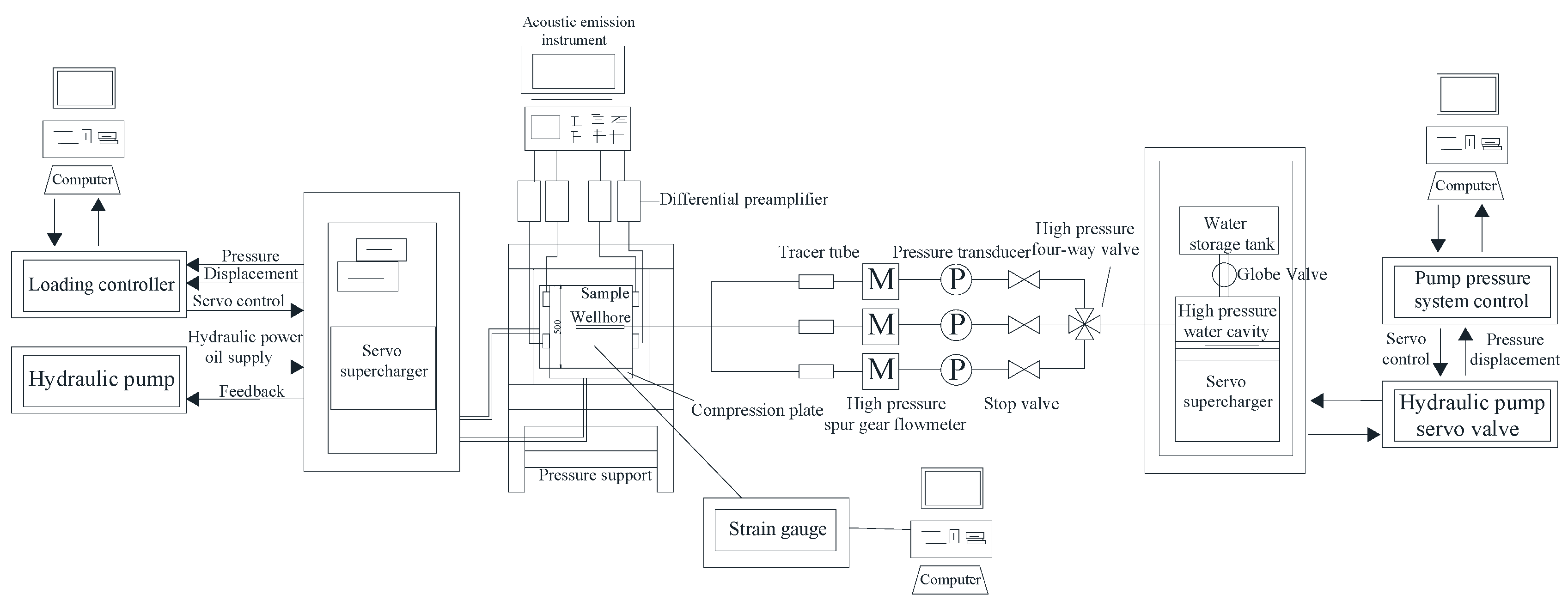
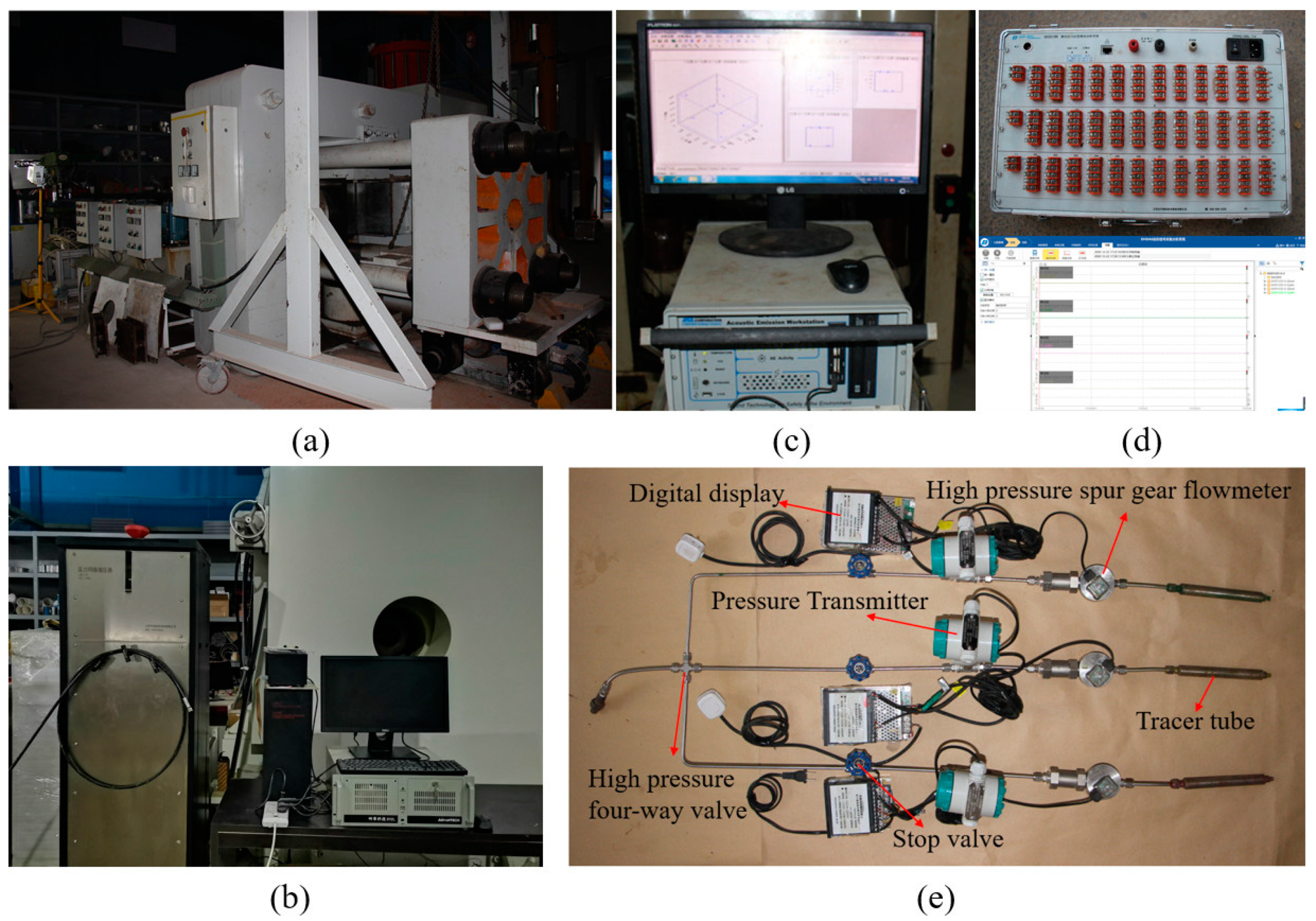


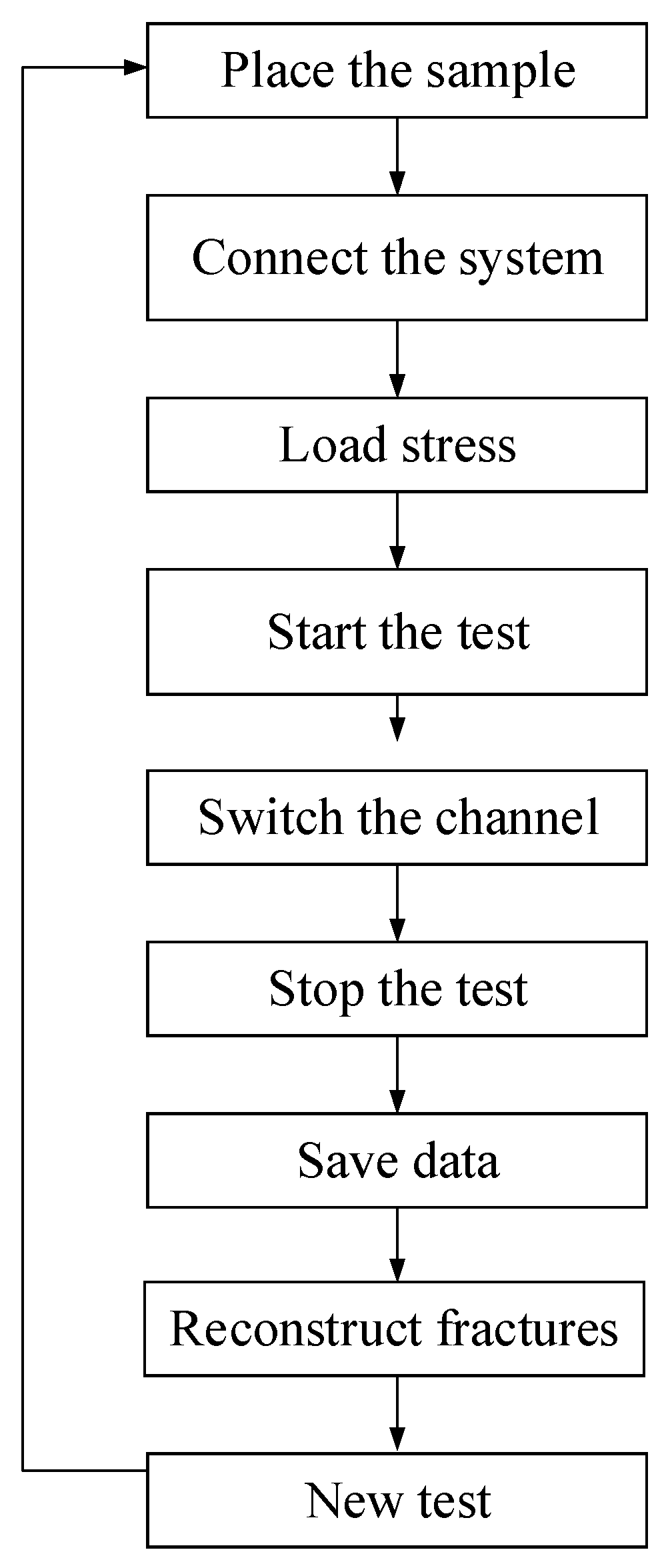
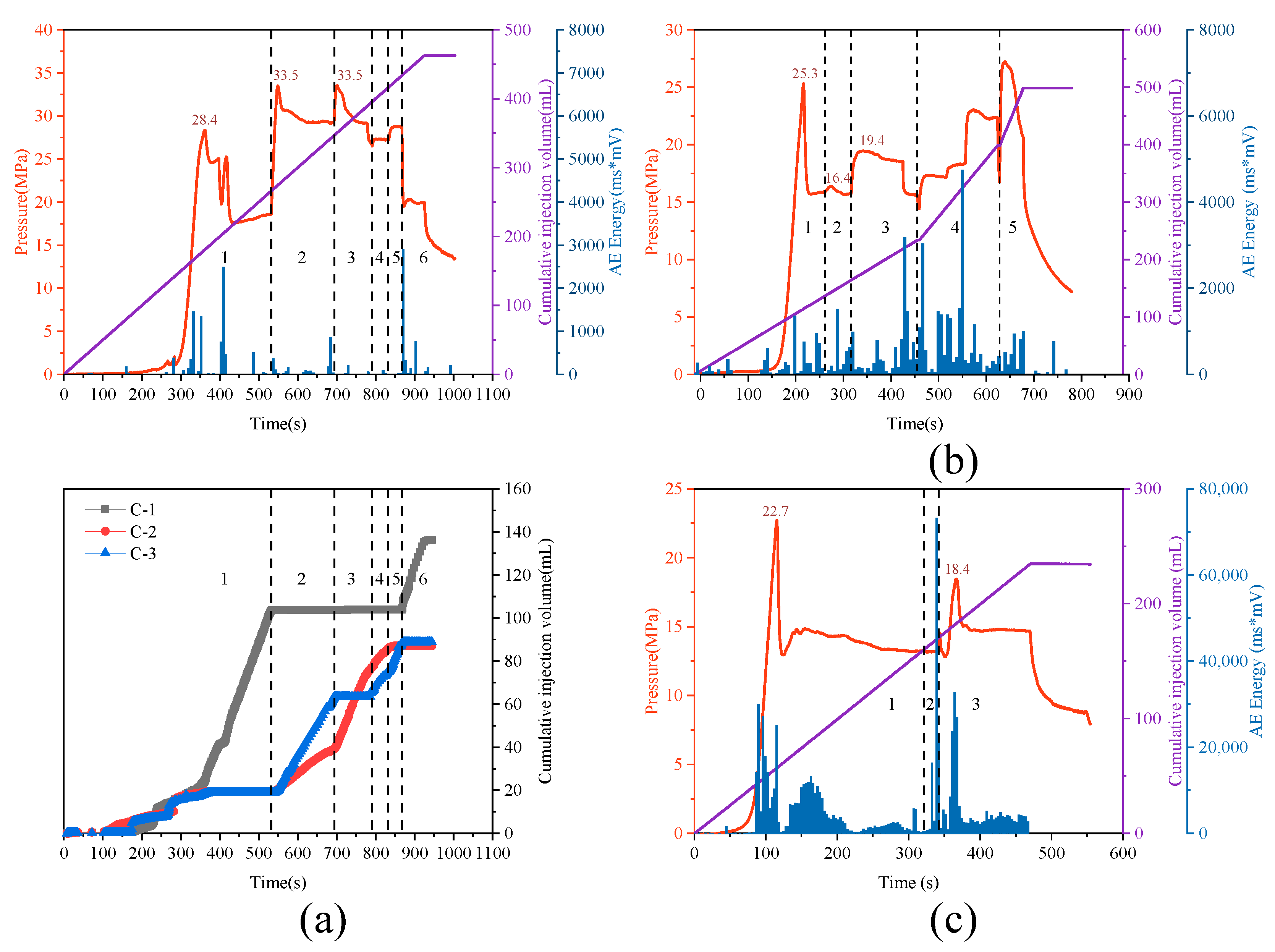

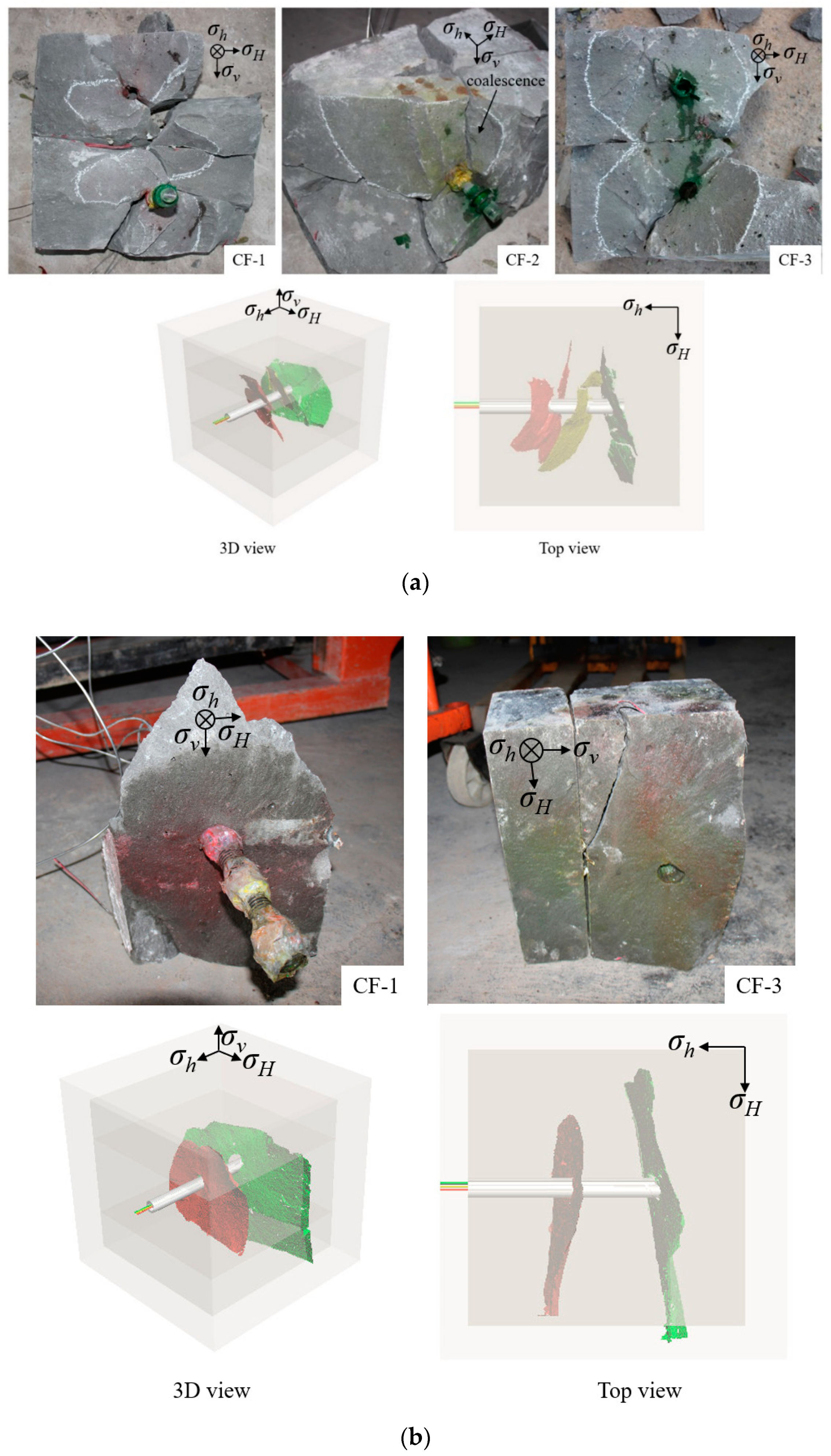

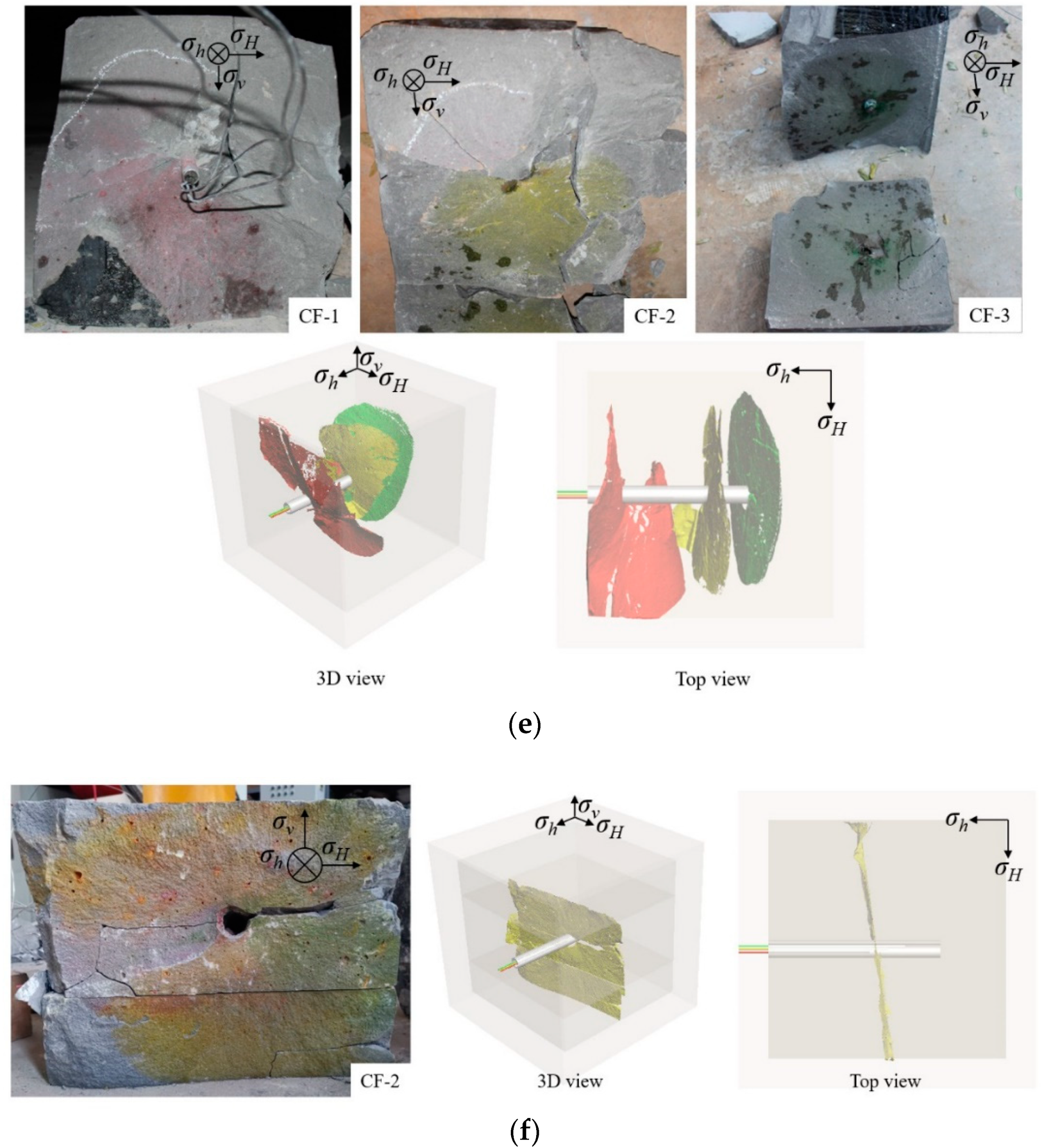
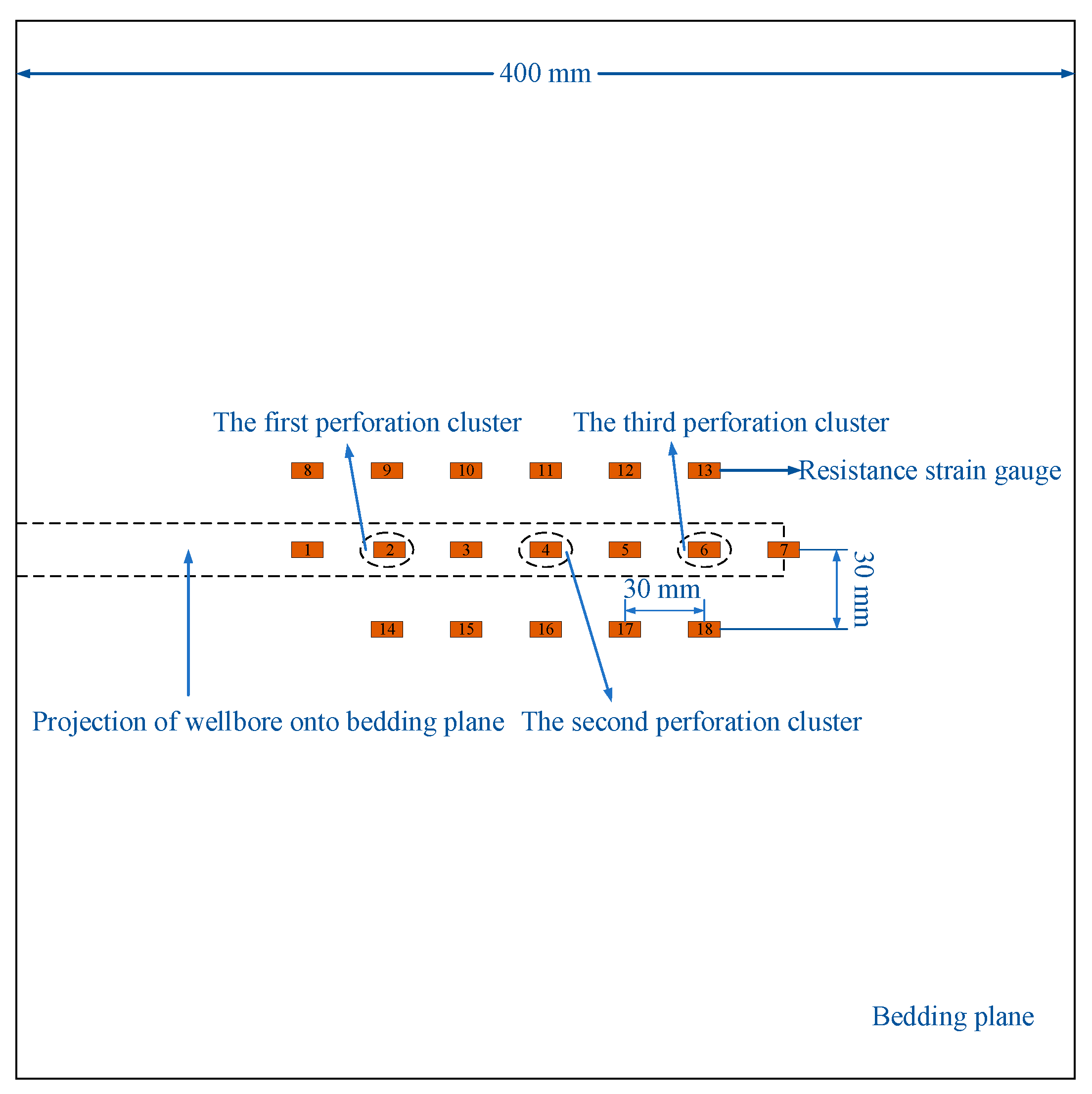
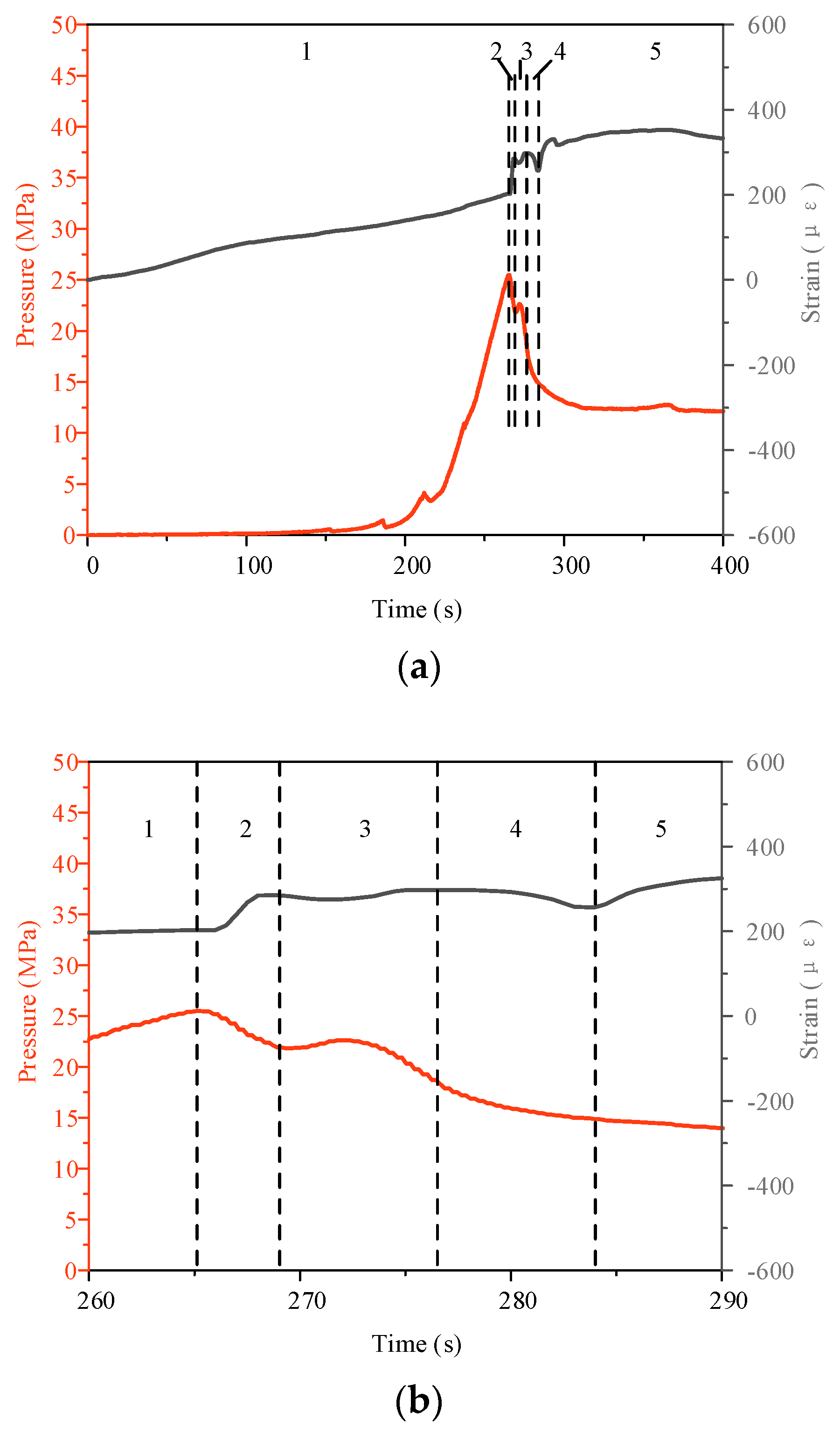
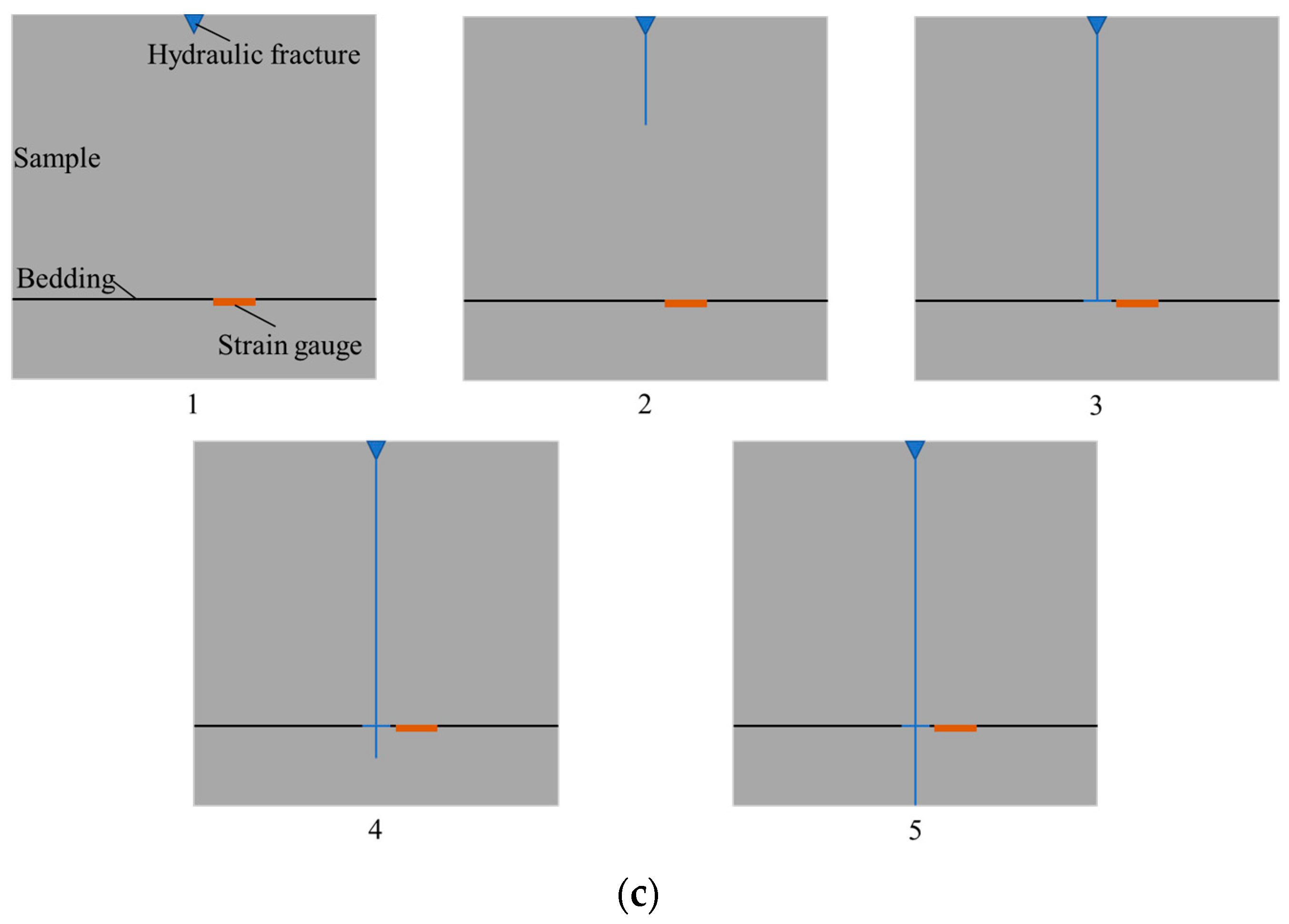
| Category | Unconfined Compressive Strength (MPa) | Young’s Modulus (GPa) | Poisson’s Ratio | Tensile Strength (MPa) |
|---|---|---|---|---|
| Artificial sample | 64.07 | 11.98 | 0.16 | 5.08 |
| Shale | 109.10 | 25.50 | 0.185 | 9.50 |
| Test | In-Situ Stress σv/σH/σh (MPa) | Pump Rate (mL/min) | Fluid Viscosity (mPa·s) | Cluster Spacing (mm) | Bedding Structure Adding Yes (Y) or No (N) |
|---|---|---|---|---|---|
| 1 | 26/25/22 | 30 | 100 | 60 | Y |
| 2 | 26/25/17 | 30 | 100 | 60 | Y |
| 3 | 26/25/12 | 30 | 100 | 60 | Y |
| 4 | 26/25/12 | 60 | 100 | 60 | Y |
| 5 | 26/25/12 | 30 | 100 | 60 | N |
| 6 | 26/25/12 | 30 | 100 | 30 | Y |
| Test | Cluster | Initiation Sequence | Breakdown Pressure (MPa) | Fracture Propagation Area/cm2 |
|---|---|---|---|---|
| Test 1 | 1 | 1 | 28.4 | 387.31 |
| 2 | 3 (simultaneous) | 33.5 | 259.11 | |
| 3 | 2 (simultaneous) | 33.5 | 493.36 | |
| Test 2 | 1 | 3 (simultaneous) | 19.4 | 547.08 |
| 2 | 1 (simultaneous) | 25.3 | 0 | |
| 3 | 2 (simultaneous) | 16.4 | 1188.92 | |
| Test 3 | 1 | 1 | 25.5 | 1478.14 |
| 2 | 2 | 29.8 | 716.63 | |
| 3 | 3 | 31.0 | 435.97 | |
| Test 4 | 1 | 2 | 28.8 | 1254.35 |
| 2 | 3 | 33.7 | 1249.13 | |
| 3 | 1 | 22.2 | 1706.77 | |
| Test 5 | 1 | 3 | 33.8 | 1055.88 |
| 2 | 1 | 28.2 | 572.79 | |
| 3 | 2 | 30.0 | 812.09 | |
| Test 6 | 1 | 1 (simultaneous) | 22.7 | 0 |
| 2 | 2 (simultaneous) | 22.7 | 1245.49 | |
| 3 | 3 (simultaneous) | 18.4 | 0 |
Publisher’s Note: MDPI stays neutral with regard to jurisdictional claims in published maps and institutional affiliations. |
© 2021 by the authors. Licensee MDPI, Basel, Switzerland. This article is an open access article distributed under the terms and conditions of the Creative Commons Attribution (CC BY) license (https://creativecommons.org/licenses/by/4.0/).
Share and Cite
Bi, Z.; Wang, L.; Yang, H.; Guo, Y.; Chang, X.; Zhou, J. Experimental Study on the Initiation and Propagation of Multi-Cluster Hydraulic Fractures within One Stage in Horizontal Wells. Energies 2021, 14, 5357. https://doi.org/10.3390/en14175357
Bi Z, Wang L, Yang H, Guo Y, Chang X, Zhou J. Experimental Study on the Initiation and Propagation of Multi-Cluster Hydraulic Fractures within One Stage in Horizontal Wells. Energies. 2021; 14(17):5357. https://doi.org/10.3390/en14175357
Chicago/Turabian StyleBi, Zhenhui, Lei Wang, Hanzhi Yang, Yintong Guo, Xin Chang, and Jun Zhou. 2021. "Experimental Study on the Initiation and Propagation of Multi-Cluster Hydraulic Fractures within One Stage in Horizontal Wells" Energies 14, no. 17: 5357. https://doi.org/10.3390/en14175357
APA StyleBi, Z., Wang, L., Yang, H., Guo, Y., Chang, X., & Zhou, J. (2021). Experimental Study on the Initiation and Propagation of Multi-Cluster Hydraulic Fractures within One Stage in Horizontal Wells. Energies, 14(17), 5357. https://doi.org/10.3390/en14175357







